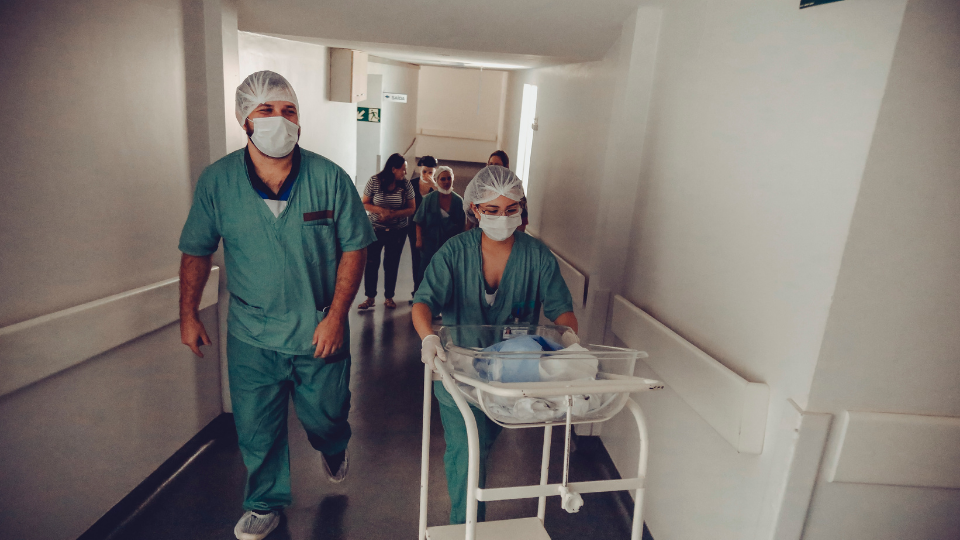
Doctors working in a hospital | Stock photo via Canva
Are you having a hard time getting an appointment with a primary care doctor? If so, you’re not alone—and the Trump administration’s anti-immigrant moves will make it even harder, especially in rural areas.
According to the Migration Policy Institute, immigrants make up nearly 20% of the healthcare workforce, including almost 40% of home health aides and over a quarter of physicians and surgeons. Most of this latter category consists of non-U.S. international medical graduates (non-U.S. IMGs)—that is, foreign nationals who attend medical school outside the United States, but move to the U.S. for residency training and practice.
Dr. Kajal Vachharajani, a recent graduate of the Guthrie Family Medicine Residency Program, is one such physician. She spent the last three years attending lectures, rounding on patients in the hospital, delivering babies, and managing her own panel of patients in the small town of Sayre, Pennsylvania.
As a J-1 visa holder, Dr. Vachharajani explains, she would normally have to return to her home country for two years before returning to practice in the United States. However, because she has taken a job in a medically underserved community, she is eligible for a waiver that allows her to apply for a work visa without returning home.
As a Canadian, Dr. Vachharajani says, she was lucky. She had less difficulty getting a visa than her peers from other countries.
Still, physicians like Dr. Vachharajani face significant barriers to practicing in the United States. Many residency programs, especially those in the highest-paid specialties, simply don’t interview physicians who attended medical school outside the United States. Others don’t accept J-1 visa holders or offer H-1B visas, the two visa programs that allow most foreign medical graduates to train and practice in the U.S.
According to Dr. Vachharajani, foreign medical graduates might have to apply to 10 times as many programs to get the same number of interviews. “I had American friends apply to 20-40 programs and land 10+ interviews,” she said, “when I applied to 140 programs and also received only 12 interview offers.”
Her experience is typical. According to the American Medical Association, international medical grads apply on average to 144 residency programs (with up to $3,750 of application fees, at 2024-25 rates). And even with that many applications, over 40% of non-U.S. IMG applicants don’t match into a residency in any given year.
And it isn’t because residencies are full of more qualified applicants. In Dr. Vachharajani’s specialty, Family Medicine, 15% of first-year residency spots went unfilled in this year’s match. In fact, more positions went unfilled (805) than were filled by foreign medical graduates (801).
These numbers might make sense if the United States were well supplied with doctors. Unfortunately, we are not—especially in primary care, where doctors are paid the least and report the highest levels of burnout. And most of us have felt that shortage. In the clinic where she did her residency, Dr. Vachharajani says, new patients might face wait times of weeks or even months for an appointment to establish with a primary care provider. “Luckily,” she adds, “we’re able to get them in sooner for acute problems.”
In its most optimistic projections, based on continued increases in funding for residency programs, the American Association of Medical Colleges predicts a shortfall of 20,200 to 40,400 primary care physicians by 2036. This shortage will be most acute in rural areas and other medically underserved communities.
It’s against this backdrop that we have to consider the Trump administration’s immigration policy and the impact it will have.
The most immediate threat comes from changes to the J-1 (exchange visitor) and H-1B (temporary skilled worker) visa programs. The importance of these programs to our healthcare system can’t be overrated. Over a quarter of first-year residents in the primary care specialties (Internal Medicine, Family Medicine, and Pediatrics) rely on one of these two visas.
On June 3, the State Department temporarily paused the application process for the J-1 visa program. When the process reopened two weeks later, it came with a warning that “a U.S. visa is a privilege, not a right,” and that applicants should expect consular officials to comb through their social media for any evidence of intent “to harm Americans or our national interest.” In other words, the administration will now treat every J-1 visa applicant as a potential national security threat.
Then, in September, the White House announced a major change to the H-1B visa program: a new $100,000 fee, to be paid by an employer for each H-1B visa they wish to sponsor. Although the healthcare sector accounts for only a small portion of H-1B visa petitions (4.3% in 2023), those visas are vital to the supply of physicians in the United States. Even doctors who pursue residency or fellowship training on a J-1 visa will often need an H-1B visa to work after graduation.
These changes are only one piece of a broader regime of hostility toward foreign nationals living and working in the United States, including those with legal status. The use of militarized ICE raids as a political spectacle, the embrace of racial profiling in immigration enforcement, and the use of detention and deportation to silence critics are likely to make foreign-trained doctors reconsider a career in the United States.
According to Dr. Michelle Nanda, this newly restrictive immigration policy could have a “crippling” effect on Family Medicine. As Associate Program Director of the residency where Dr. Vachharajani trained, Dr. Nanda organizes the program’s recruitment of new residents.
Over her tenure in that role, the percentage of residents on J-1 and H-1B visas has increased significantly. That shift aligns with a general trend in Family Medicine, and primary care more broadly, as debt-burdened U.S. medical graduates seek out higher-paying specialties. But it is also an unintended consequence of a very conscious decision about recruiting.
Primary care residencies, and Family Medicine residencies in particular, tend to be less competitive than residencies in the higher-paid specialties, like Radiology or Dermatology. Rural programs like Dr. Nanda’s are at an even greater disadvantage when it comes to attracting residents.
As a result, many candidates apply to those programs as a fallback, in case they don’t match into a program in their first-choice specialty. And that has consequences for residents, for residency programs, and ultimately for patients. “We have good data,” Dr. Nanda says, “to show that residents are happier and more satisfied with their training when they are in a specialty they want.”
Based on that data, the faculty of Guthrie’s Family Medicine residency decided to change their approach to recruiting. Rather than seeking out the highest test scores or prioritizing candidates from U.S. medical schools, they began looking for candidates who demonstrated a commitment to Family Medicine. Dr. Cori Marshall, who teaches in the residency and serves as medical director of its clinic, summed up their reasoning: “We can teach people to practice Family Medicine. We can’t teach people to want to practice Family Medicine, or to value primary care.
That change in recruiting also resulted in a shift toward non-U.S. international medical grads, like Dr. Vachharajani. Currently, all but one of the program’s 18 residents come from abroad, on either a J-1 or an H-1B visa. Of the 1,320 applications the program has received for the six spots in next year’s cohort, only 120 are from U.S. citizens.
In this context, the new $100,000 fee for H-1B visas will hit especially hard. Because H-1B visas are sponsored by the employer and make it easier to apply for permanent status, programs that can offer them have an advantage in recruiting. With H-1B visas now out of reach for her program, Dr. Nanda predicts, next year might be the first time that Guthrie’s Family Medicine residency is unable to fill its first-year class.
And because residents are health care providers in their own right, with their own patient panels, fewer residents means fewer doctors and longer wait times. “As a rural primary care program,” Dr. Nanda says, “we depend on foreign medical graduates. Anything that limits our ability to recruit them is going to interfere with patient care.”
What this situation shows, more than anything, is the bad faith of right-wing rhetoric on immigration. MAGA extremists obsess over the idea that foreign nationals living and working here are somehow taking advantage of, or even threatening, the United States and its citizens.
But in health care, as in many other areas, reality tells a different story. Without foreign medical graduates, many of us would be without access to primary care. If the Trump administration’s definition of national security included the basic welfare of the nation’s people, it would address the deepening crisis in our primary care system rather than targeting the people and the programs keeping it afloat.
As with all op-eds published by People’s World, the views reflected here are those of the author.
We hope you appreciated this article. At People’s World, we believe news and information should be free and accessible to all, but we need your help. Our journalism is free of corporate influence and paywalls because we are totally reader-supported. Only you, our readers and supporters, make this possible. If you enjoy reading People’s World and the stories we bring you, please support our work by donating or becoming a monthly sustainer today. Thank you!
CONTRIBUTOR

